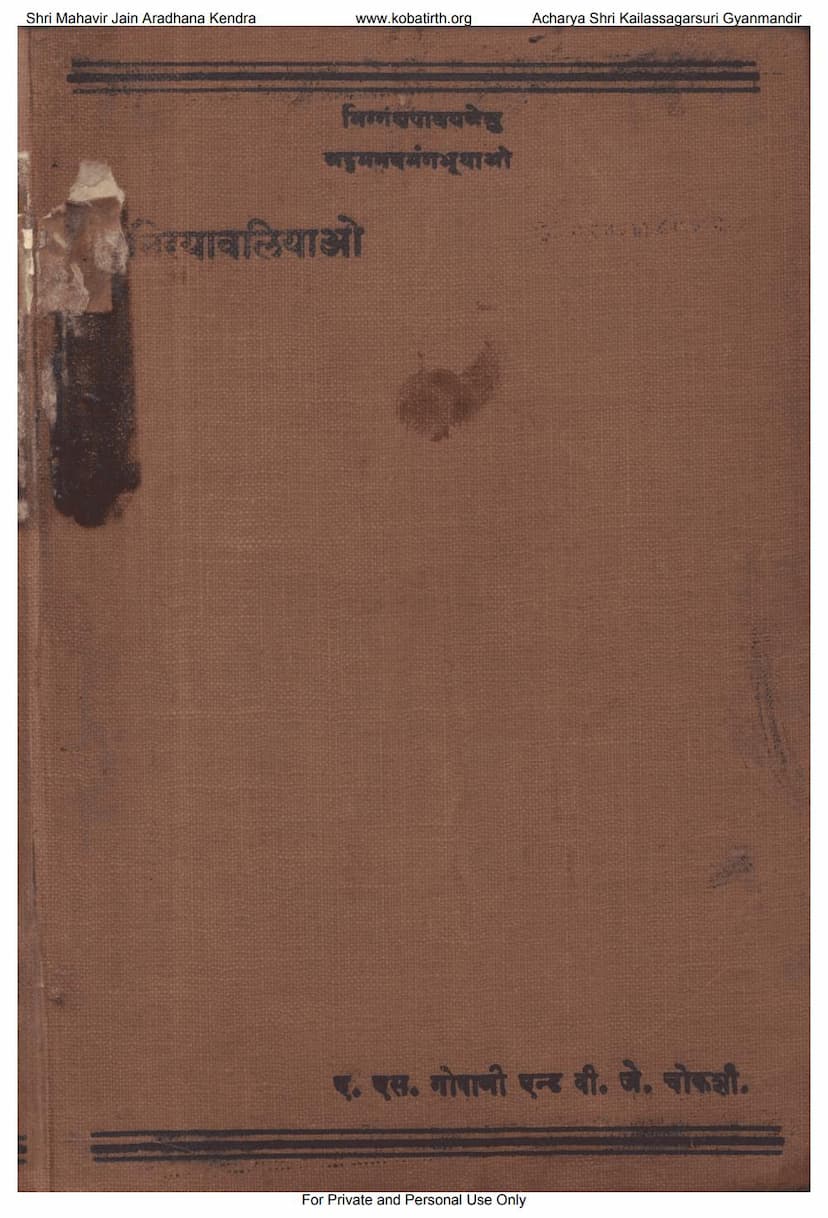Nirayavaliyao
Added to library: September 2, 2025

Summary
Here's a comprehensive summary of the Jain text "Nirayavaliyão" based on the provided information:
Book Title: Nirayavaliyão (also referred to as Nirayāvaliyão) Authors: A. S. Gopani, V. J. Chokshi Publisher: Gurjar Granthratna Karyalay Edition Year: 1934
Overview:
The "Nirayavaliyão" is identified as the last five Upangas of the Jain Canon. The term "Upanga" refers to subsidiary canonical texts in Jainism that complement the main Angas. This specific collection is composed of five distinct texts:
- Nirayavaliyão (proper): Also known as Kappiyā (the basis or foundation) or "The series of persons who went to Hell."
- Kappavadinsiyão: An appendix to Kappiyā.
- Pupphiyā: Another appendix to Kappiyā.
- Pupphachuliyio: An appendix to Pupphiyā, or the pupils of Pupphachulās.
- Vanhidasão: The ten (though later specified as twelve) chapters on the Vrsnis.
The entire volume is presented in five sections, with the first four sections containing ten lectures (adhyayanas) each, and the fifth section containing twelve lectures.
Content Summary (Section by Section):
The introduction by the editors provides insights into the themes of each section:
-
Section I (Nirayavaliyão / Kappiya):
- Lecture 1 (Kila): Focuses on the story of Kila and his step-brothers. It emphasizes the dire consequences of undertaking actions, even warfare, for an unrighteous cause, leading to miseries of hell. The text draws a parallel to modern political principles, suggesting that religious and philosophical principles are vital for universal peace and happiness, applicable even in practical politics. The importance of fighting for a righteous cause is highlighted.
- Lectures 2-10: Described as replicas of the first lecture, suggesting a thematic continuation.
-
Section II (Kappavadinsiyão):
- Lectures 1-10: This section emphasizes the importance of the religious life of a Jain monk who practices severe penance for twelve years, ultimately leading to religious death (Anasanas) which results in heaven and eventually liberation.
-
Section III (Pupphiyā):
- Lectures 1-2: Reiterate themes from the previous section.
- Lecture 3: Highlights the superiority of Jain vows of renunciation over Brahmanic vows of asceticism, using supernatural elements and divine testimony to emphasize Jain principles. It also provides historical information on Brahmanical practices in the 6th century BC and discusses the concept of planets as living beings in Jain mythology.
- Lecture 4: Discusses the societal craving for children, particularly sons, in ancient India (5th-6th century BC) from a Jain perspective. It states that the gift of children depends on religious merit, not divine intervention, and that such desires are considered a sin. Religious practices are the only means to overcome worldly worries, and even then, the focus should be on accumulating merit, not satisfying cravings.
- Lectures 5-10: Described as running on parallel lines with previous lectures.
-
Section IV (Pupphachūliyā):
- Lecture 1 (Bhûtāl): Emphasizes Jain belief in the sanctity and life within water (Sachitta). The use of water, especially cold water, is considered sinful due to the birth and death of subtle souls within it. Strongly heated water can be used after cooling, but only for a limited time. Stricter rules are for monks and nuns, while householders are advised to use water with great care.
- Lectures 2-10: Described as running on parallel lines.
-
Section V (Vanhidasão):
- Lectures 1-12: This section, like the second section, emphasizes the religious life of a Jain monk, detailing the hardships and troubles they endure, such as nudity, head-shaving, no bathing, no teeth cleaning, not using umbrellas or shoes, sleeping on wooden beds, hair-plucking, celibacy, begging for alms, accepting alms with equanimity, and patiently bearing troubles from ignorant people. The section concludes with this noble teaching.
Editorial Features:
The edition by Gopani and Chokshi is noted for its comprehensiveness, including:
- Introduction
- Translation (literal and complete English)
- Notes
- Glossary
- Appendices (including detailed descriptions of cities, temples, and significant characters, often referred to as "Varnaka")
- Critical footnotes
Significance:
The foreword highlights the importance of such works for the study of Ardha-Magadhi and Jain literature. It also emphasizes the value of critical editions and English translations in making Jain scriptures accessible to a wider audience, particularly students. The text is seen as offering profound lessons on righteousness, penance, the consequences of actions, and the path to liberation, with strong ethical and social implications relevant even in contemporary times.
In essence, the "Nirayavaliyão" is presented as a collection of narratives illustrating Jain principles of karma, penance, renunciation, and the path to spiritual upliftment through the lives of various individuals, including royalty, ascetics, and common people, across different realms of existence.